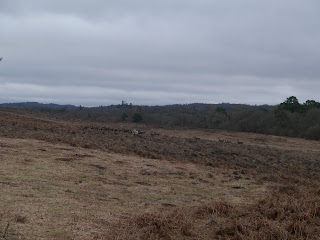With grey, overcast skies, we opted for a long loop across the New Forest, starting at Blashford Lakes, and heading up onto Ibsley Common for lunch at the High Corner Inn, before returning via Rockford Common.
We started with a quick visit to the bird hide on Ivy Lake - what initially appeared as bare quickly - through my trusty binoculars - revealed a good smattering of bird species. Pochard, lapwing, tufted duck, cormorant, little grebe, possibly some goldeneye. Our route took us along the pretty New Forest stream of Dockens Water, with snowdrops flowering on its banks, and the pale-yellow blooms of wild daffodil about to erupt.
We were quickly - via a great deal of mud - up on a wide and ancient track through the heathland, with good views down to Linwood Bog, and up towards the ridge top, where a kestrel was hunting. Suddenly, I rounded a gorse bush to be greeted by a large herd of fallow deer, including one noticeably pale. Having spotted us, they charged up the hill, then decided better of it and charged back down again, taking safety in the wetter lower slopes.
We continued our route, veering right, towards the bog itself, hoping to pick up a footpath and not be lost to the quagmire. It wasn't too bad, although looks can be deceiving as I found out, suddenly finding myself on a thick but most definitely-wobbling surface of vegetation, as we had stumbled into that most rare and unusual habitat, the quaking bog. A most peculiar feeling, and yet another reason why the New Forest is so special.
Finally crossing the bog, and Dockens Water again, we made our way to a cycle path through heathland and woodland, skirting farms and large trees with woodpeckers drumming out their territories. Time for lunch!
 Our route back was much less eventful, although not the same, taking a lower route across Rockford Common, with its wide vistas and large herds of wild livestock - cows and ponies this time. We retraced our steps towards Blashford Lakes, stopping to admire the gall burden on some of the bushes (the remains of gall wasp larvae feeding then hatching out), before a final look in the Ivy lake hide. This time, we found the lesser-spotted Twitcher - a see of scopes as the large mass of roosting gulls that had appeared in our absence might possibly have a Thayer's Gull. We left them to it - enough excitement for one day!
Our route back was much less eventful, although not the same, taking a lower route across Rockford Common, with its wide vistas and large herds of wild livestock - cows and ponies this time. We retraced our steps towards Blashford Lakes, stopping to admire the gall burden on some of the bushes (the remains of gall wasp larvae feeding then hatching out), before a final look in the Ivy lake hide. This time, we found the lesser-spotted Twitcher - a see of scopes as the large mass of roosting gulls that had appeared in our absence might possibly have a Thayer's Gull. We left them to it - enough excitement for one day!



